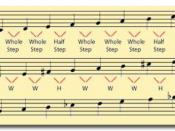Modes are simply the name given to the pattern of intervals between each note in an octave. Modes and Scales can be traced back to Greek origins, where different tribes evolved different scales. Each scale started on a different note and descended by characteristic intervals. In the middle ages, the church adopted these scales, made them ascending from a tonic note and renamed them modes. They were the tonal basis of Gregorian Chant and are the origins of western music theory. They are in no way related to the Greek modes except that the names. All of the church modes consist of the notes of the C-Major scale but use various notes as the tonal center. Consider the distance between two pitches, one with twice the frequency of the other. If you subdivide this into twelve equal intervals, you get the well-tempered chromatic scale. The names of the church modes are Ionian, Dorian, Phrygian, Lydian, Mixolydian, Aeolian, and Locrian, and they match geographic or ethnic regions in ancient Greece.
Plato and Aristotle believed that the modes to which a person listened molded the person's character. One problem is that, whereas many writings specify how the ancient Greeks thought about scales, and how they constructed some of their scales, nothing exists to identify which modes were called Mixolydian, Dorian, Phrygian, etc. The early Christian Church used music in worship. Their modes came from Jewish temple songs and from other common modes in the Middle East and Eastern Mediterranean. The church modes are in no way derived from a major scale. They were used for centuries before the major-minor scale system was developed.



Walking a thin line...
While the shortness of this piece is pushing the envelope...the fact that it provides enough information for three good notecards I'd say it deserves an average rating...
I know you can do better though, EnergyCoffee...
2 out of 3 people found this comment useful.